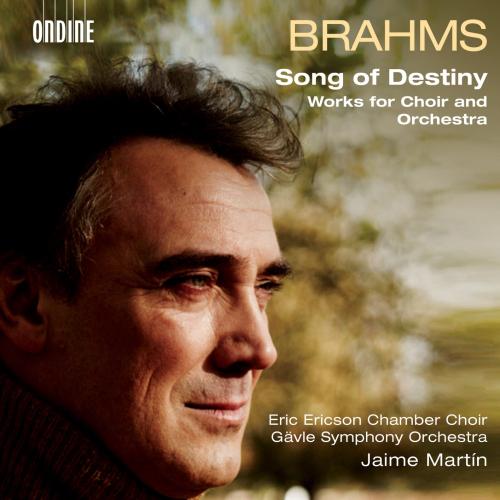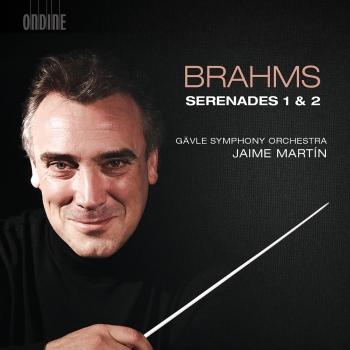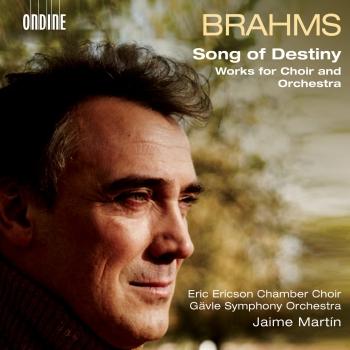
Brahms: Works for Choir & Orchestra Gävle Symfoniorkester & Jaime Martín
Album Info
Album Veröffentlichung:
2017
HRA-Veröffentlichung:
10.11.2017
Label: Ondine
Genre: Classical
Subgenre: Choral
Interpret: Gävle Symfoniorkester & Jaime Martín
Komponist: Johannes Brahms (1833-1897)
Das Album enthält Albumcover Booklet (PDF)
- Johannes Brahms (1833 - 1897):
- 1 Schicksalslied, Op. 54 15:06
- 2 Gesang der Parzen, Op. 89 11:01
- 3 Nänie, Op. 82 11:57
- 4 Begräbnisgesang, Op. 13 06:15
- 18 Liebeslieder Waltzes, Op. 52 (Version for Choir & Orchestra):
- 5 No. 1, Rede, Mädchen 01:03
- 6 No. 2, Am Gesteine rauscht die Flut 00:45
- 7 No. 4, Wie des Abends schöne Röte 00:45
- 8 No. 6, Ein kleiner, hübscher Vogel 02:27
- 9 No. 5, Die grüne Hopfenranke 01:30
- 15 Neue Liebeslieder Waltzes, Op. 65 (Version for Choir & Orchestra):
- 10 No. 9, Nagen am Herzen 01:34
- 18 Liebeslieder Waltzes, Op. 52 (Version for Choir & Orchestra):
- 11 No. 11, Nein, es ist nicht auszukommen 00:57
- 12 No. 8, Wenn so lind dein Auge 01:27
- 13 No. 9, Am Donaustrande 02:07
Info zu Brahms: Works for Choir & Orchestra
The series of Brahms recordings on Ondine with the Gävle Symphony Orchestra and their chief conductor Jaime Martín follow up with this recording of works for choir and orchestra together with the prestigious Eric Ericson Chamber Choir.
Jaime Martín became the Artistic Director and Principal Conductor of Gävle Symphony Orchestra in 2013. During recent years orchestral engagements have led the rising conductor to collaborate with several prominent orchestras around the world. Martín is also Chief Conductor of the Orquestra de Cadaqués and known for his active career as solo flautist.
Brahms’ impressive Schicksalslied was written in 1868. The work delves musically into the duality between the “fate-free,” ideal heavenly life and the existence of “suffering man” on earth articulated in Friedrich Hölderlin’s poem. During the summer of 1881 Brahms composed his Nänie on a poem by Friedrich von Schiller as a song of lament and mourning for the fleetingness of beauty. Brahms dedicated this work to Henriette Feuerbach, the mother of painter Anselm Feuerbach, Brahms’s highly admired friend, who had died in Venice in 1880. Gesang der Parzen was premiered the following year conducted by the composer in Basel on 10 December 1882. The theme of destiny is an obvious parallel that can be drawn between this work and the Schicksalslied. Written for choir and wind instruments, Begräbnisgesang is an early work of funeral music. The final version of the work was completed in 1859. Brahms wrote his hugely successful Liebeslieder Waltzes Op. 52 & 65 during 1869–74. This album includes a selection adapted by the composer.
Eric Ericson’s Chamber Choir was founded in 1945 by then 27-year-old Eric Ericson, and has since taken a central position in the Swedish and international music scene. On the world stage, Eric Ericson’s Chamber Choir is among the very foremost professional ensembles, and through the years it has been awarded many distinctions. Highlights of the international work include collaborations with the Swedish Radio Choir and the Berlin Philharmonic Orchestra, with conductors such as Claudio Abbado, James Levine and Riccardo Muti, as well as the many recordings and concerts with Nicolas Harnoncourt and the Concentus Musicus Wien.
Gävle Symphony Orchestra, founded in Sweden in 1912, has a long and exciting history. Since 2013, the orchestra has enjoyed a fruitful musical partnership with principal conductor Jaime Martín, but the orchestra has also collaborated regularly with renowned international conductors. The orchestra has also started a collaboration with the Eric Ericson Chamber Choir leading to a recording of Johannes Brahms’ Cantatas for choir and orchestra to be released by Ondine.
Eric Ericson Chamber Choir
Gävle Symphony Orchestra
Jaime Martín, conductor
The Gävle Symphony Orchestra
founded in 1912, has a long and exciting history, but its focus is always on the future. Each concert presents an opportunity to deliver the very best, and to meet the expectations of the audience for an artistic experience at the highest level.
The orchestra has since its inception played an obvious and significant role in the Swedish music scene and its 52 musicians are driven by an undeniable and heartfelt passion for music. The orchestra takes on a repertoire ranging from the baroque to the latest contemporary music with equal curiosity and dedication. It is of particular note that the orchestra’s initiatives with composers-in-residence have provided a vivid image of the outside world. Through a series of acclaimed CD recordings, the Gävle Symphony Orchestra has also brought many older Swedish composers into the limelight and given them well-deserved recognition.
Since 2013, Gävle Symphony Orchestra has enjoyed a fruitful musical partnership with principal conductor Jaime Martín and the orchestra has also collaborated regularly with renowned conductors such as Leif Segerstam and the late Sir Neville Marriner. Among returning soloists you find stars Isabelle van Keulen, François Leleux, Gabriela Montero and many others. During Jaime Martín’s tenure as principal conductor, the Gävle Symphony Orchestra has also started a collaboration with the Eric Ericson Chamber Choir.
Jaime Martín
has risen quickly to international acclaim as a conductor following his prominent career as a flautist. In 2013 he became Artistic Director and Principal Conductor of Gävle Symphony Orchestra and he is also Chief Conductor of the Orquestra de Cadaqués and Artistic Director of the Santander International Festival.
As a guest conductor Martín has worked extensively with orchestras throughout the UK and Ireland, including the London Philharmonic Orchestra, Philharmonia Orchestra, Royal Scottish National Orchestra, Academy of St. Martin in the Fields, London Mozart Players, BBC Symphony Orchestra, the Ulster Orchestra and RTE Orchestra. He has also conducted the Orchestre Philharmonique de Radio France, Royal Liverpool Philharmonic Orchestra, Swedish Radio Symphony Orchestra, Saint Paul Chamber Orchestra, New Zealand Symphony Orchestra, Queensland Symphony Orchestra, Orquestra Sinfônica do Estado de São Paulo, Lausanne Chamber Orchestra, National Orchestra Lyon, Beijing Symphony Orchestra, Winterthur Orchestra, Orquestra Sinfònica de Barcelona and the Royal Flemish Philharmonic. He made his debut at the English National Opera in February 2013 conducting Barber of Seville and returned in autumn 2014 to conduct Marriage of Figaro.
Previous recordings include Schubert’s Symphony No. 9, Montsalvatge’s Petita Suite Burlesca, Halffter’s Sinfonietta and Beethoven’s Symphony No. 3 “Eroica” with the Orquestra de Cadaqués for Tritó. Solo recordings include Mozart concertos with Sir Neville Marriner, a premiere recording of the Sinfonietta Concerto for Flute and Orchestra written for him by Xavier Montsalvatge and conducted by Gianandrea Noseda, Bach works for flute, violin, and piano with Murray Perahia and the Academy of St. Martín in the Fields for Sony Classical.
Booklet für Brahms: Works for Choir & Orchestra










